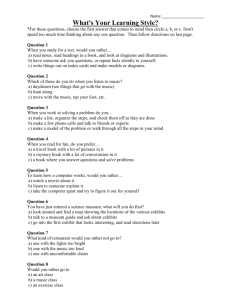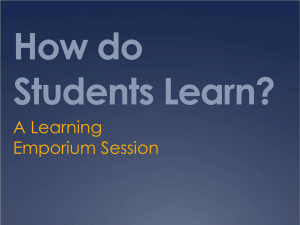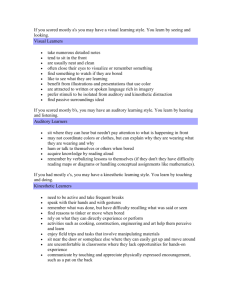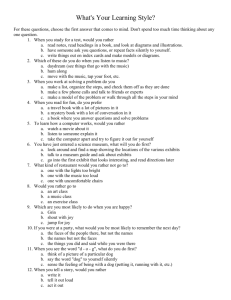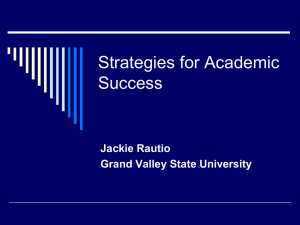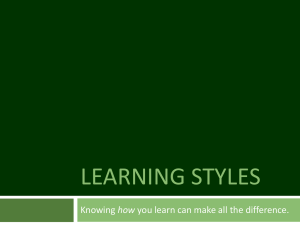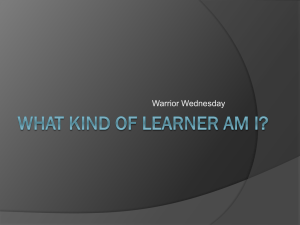An Introduction to Understanding Learning Styles
advertisement
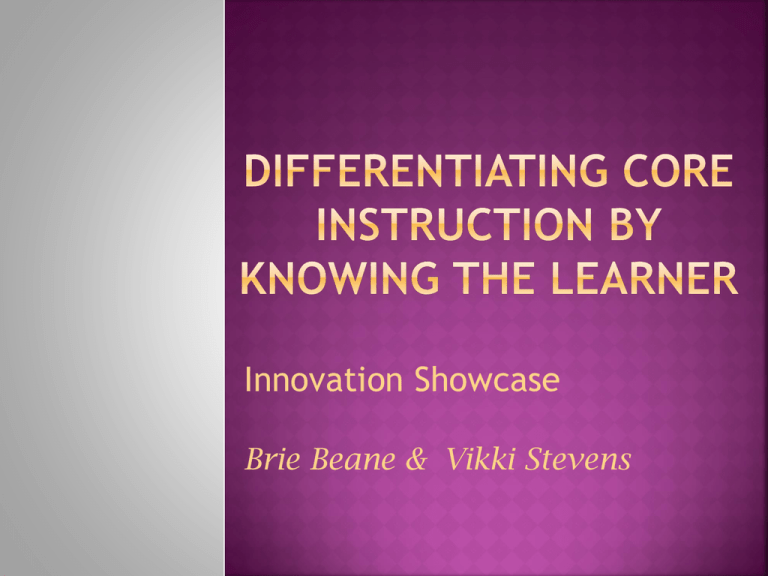
Innovation Showcase Brie Beane & Vikki Stevens 1. Go to the i3 + C3 wiki i3c3.pbworks.com 2. Think about what kind of learner you are: visual, auditory, or kinesthetic. 3. Take a dot from your table and post it to the board under the “Pre” column for how you think you learn best. Red=Visual Green = Auditory Yellow=Kinesthetic Identify your particular learning style Understanding your particular learning style and how to best meet the needs of student with that learning style. Recognizing student behaviors in the learning environment How to provide opportunities for students to select and use the most effective learning style as they are working and learning. Go to the wiki: http://i3c3.pbworks.com Select a “Learning Styles Inventory” from those listed DIFFERENTIATION Curriculum: Content/Process/ Product/Environment Student: Readiness/Interest/Learning Style Did you know… Grades K-2 are primarily taught kinesthetically Grades 3-6 are primarily taught visually Grades 7-12 are primarily taught auditorily Did you also know… Statistics reveal that most high school dropouts are kinesthetic learners. 80% of prison inmates are high school dropouts. - Northwest Regional Educational Laboratory (NWREL) The Parent Project (a research-based parenting program) reports that 80% of the prison population are kinesthetic learners But, What are Learning Styles? Your modality indicates what you need to be able to: •Concentrate •Learn •Process •File Information STUDENT OUTCOMES: You will learn more easily and with greater success once you have unlocked your learning style and discovered the best methods for helping you learn. You may be surprised to discover just how well you can flourish in the classroom, even in subjects that you previously found difficult! Visual Learners Typically learn through what they are able to see with their own eyes. These students jockey for the positions at the front of the class, must have front row theater seats and love to be right up front for sporting events in order to obtain the best view. Student can use Teacher can offer Charts, worksheets, diagrams Webbing, mapping, graphic organizers Seating in class Notetaking / visual images Use Frameworks Computer typing Diary notes, Concept mapping Organizational checklists Genre / report processes Assessment timetables Clear visual cues See the big picture cues See information on WB SAY to a partner what you understand about VISUAL LEARNERS. WRITE on a sticky note how visual students may appear to be “off task” or how students could “show what I know” based on what you’ve just learned about VISUAL LEARNERS. DO/Using any materials (located in the center of your table), create something VISUAL that symbolizes what you’ve just learned. Auditory Learners Auditory learners are very good listeners. They tend to absorb information in a more efficient manner through sounds, music, discussions, teachings, etc. These individuals will be more likely to record lectures so that they can replay them at a later time for study purposes. Student can use Clear instructions & directions Oral Expressive Language Listening oral presentation / Teacher can offer Brief - to the point verbal cues Written supports Media supports - video’s Spelling supports Computer programs multimedia supports Praise Sight word vocabularly Computer programs Calculators Reading aloud SAY to a partner what you understand about AUDITORY LEARNERS. WRITE on a sticky note how visual students may appear to be “off task” or how students could “show what I know” based on what you’ve just learned about AUDITORY LEARNERS. DO/Using any materials (located in the center of your table), create something AUDITORY that symbolizes what you’ve just learned. Kinesthetic Learners Kinesthetic learners are tactile learners. They learn best through moving, doing, acting out and touching. Projects that are hands-on in nature are best for kinesthetic learners. Student can use Hands on activities Quick writing activities Memory strategies Teacher can offer Concrete Manipulative Responsible rules Breaks Assistive Technology Seat changes Guided practice support Meta-cognitive strategies SAY to a partner what you understand about KINESTHETIC LEARNERS. WRITE on a sticky note how visual students may appear to be “off task” or how students could “show what I know” based on what you’ve just learned about KINESTHETIC LEARNERS. DO/Using any materials (located in the center of your table), create something KINESTHETIC that symbolizes what you’ve just learned. Based on YOUR modality: Visually Auditory Kinesthetically Record/capture/note your overall learning or “a-ha” moments from this session. How did the regular “SAY, WRITE, DO” segments increase your engagement and understanding? How might you use “SAY, WRITE, DO” in your classroom this week? Discuss at your table: What did you learn about Yourself? Your students? Your colleagues? Your family members?

